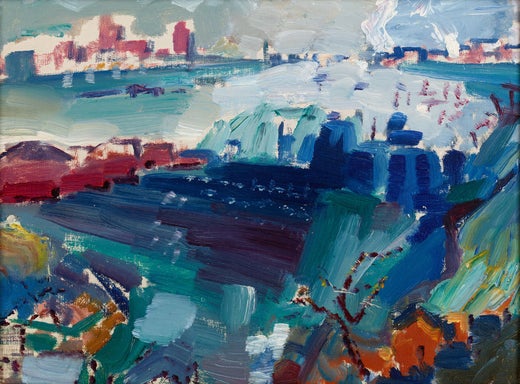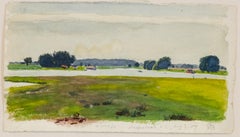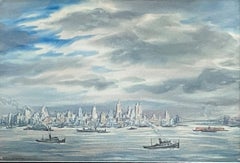Want more images or videos?
Request additional images or videos from the seller
1 of 7
John Marin"Looking out the Window, West Point, Maine, " John Marin, Modernist Landscape1914
1914
$55,000List Price
About the Item
- Creator:John Marin (1870-1953, American)
- Creation Year:1914
- Dimensions:Height: 23.5 in (59.69 cm)Width: 19.5 in (49.53 cm)
- Medium:
- Movement & Style:
- Period:
- Condition:
- Gallery Location:New York, NY
- Reference Number:1stDibs: LU1841211694732
John Marin
John Marin was born in Rutherford, New Jersey in 1870. His father was a public accountant; his mother died nine days after his birth. He was taken to his maternal grandparents with whom he lived in Weehawken, New Jersey. His grandparents, with their son and two daughters were the only parents Marin was to know; it has been suggested that his father seems to have ignored him. As a child of seven or eight Marin began to sketch and when he was a teenager he had completed his earliest watercolors. His education in the schools of New Jersey was interspersed with summers of hunting, fishing and sketching; he traveled in the Catskills, and as far away as Wisconsin and Minnesota. But formal training was almost incidental to his development as an artist. He is to America what Paul Cezanne was to France - an innovator who helped to oppose the influence of the narrative painters, the illustrators who were more interested in subject than form, in surface than substance. Marin brought to his work a combination of values which, at the turn of the century, was unique in this country: an aliveness of touch, colors that have both sparkle and solidity, and forms that are vibrant with an energy characteristic of our age. Marin established himself as a practicing architect. In the early 1890s, he worked for four architects and by 1893 had designed six houses in Union Hill, New Jersey. At the age of twenty-eight, he decided to become a professional artist and studied briefly at the Pennsylvania Academy of Fine Arts in Philadelphia and the Art Students League in New York City. As a watercolorist he had no equal. He used this fluid, spontaneous medium to abstract from objects - skyscrapers, boats, mountains and seas - a simplified anatomy of color and form and to define the pulsation of stresses and movements in the relationship of objects. It was a great disappointment, all his life, that his oil paintings did not achieve the popularity that his watercolors did. From 1905 to 1910 he worked in Europe, where he was influenced by Whistler's watercolors. It was Alfred Stieglitz, Marin's lifetime friend and dealer, whose firm faith in his genius made his position in the art world possible. He developed a distinctive style that he used most characteristically in powerful watercolors of the Maine coast. During the 1920s he provided the dominant force in the movement away from naturalistic representation towards an art of expressive semi-abstraction. He married Marie Jane Hughes after he returned to New York. They had one son, who grew up to run his father's considerable affairs. Marin continued to work at the same steady fast pace as long as he lived. Since 1908 he had produced 1700 paintings, an average of forty a year. He had made the frames for them as well. At the age of seventy-nine, he began to taper off from the days when he painted one hundred watercolors in a summer. He died in 1953.
About the Seller
5.0
Platinum Seller
Premium sellers with a 4.7+ rating and 24-hour response times
Established in 2022
1stDibs seller since 2022
122 sales on 1stDibs
Authenticity Guarantee
In the unlikely event there’s an issue with an item’s authenticity, contact us within 1 year for a full refund. DetailsMoney-Back Guarantee
If your item is not as described, is damaged in transit, or does not arrive, contact us within 7 days for a full refund. Details24-Hour Cancellation
You have a 24-hour grace period in which to reconsider your purchase, with no questions asked.Vetted Professional Sellers
Our world-class sellers must adhere to strict standards for service and quality, maintaining the integrity of our listings.Price-Match Guarantee
If you find that a seller listed the same item for a lower price elsewhere, we’ll match it.Trusted Global Delivery
Our best-in-class carrier network provides specialized shipping options worldwide, including custom delivery.You May Also Like
Hopeful Spring, 2020, watercolor, oil pastel, green, landscape, fantasy, trees
By Shamona Stokes
Located in Jersey City, NJ
Hopeful Spring, 2020, watercolor, oil pastel, green, landscape, fantasy, trees.
Hand signed by artist
Certificate of Authenticity included
Framing available
Category
2010s Contemporary Landscape Paintings
Materials
Paper, Oil Pastel, Ink, Acrylic, Watercolor, Color Pencil, Graphite
Price Upon Request
H 29.75 in W 22.5 in D 0.125 in
Gift, 2020, watercolor, oil pastel, pink, orange, rabbit, ink, fantasy
By Shamona Stokes
Located in Jersey City, NJ
Gift, 2020, watercolor, oil pastel, pink, orange, ink, fantasy, rabbit.
Hand signed by artist
Certificate of Authenticity included
Framing available
Category
2010s Contemporary Landscape Paintings
Materials
Paper, Oil Pastel, Ink, Watercolor, Graphite
Price Upon Request
H 29.75 in W 22.5 in D 0.125 in
1950s Denver Skyline Painting – Graphite & Watercolor Colorado Cityscape Art
Located in Denver, CO
A captivating midcentury cityscape titled "Denver Skyline", this original 1950s watercolor and graphite painting offers a rare industrial-era view of lower downtown Denver, Colorado....
Category
1950s American Impressionist Landscape Paintings
Materials
Watercolor, Graphite
$1,950
H 17.5 in W 21.5 in D 0.75 in
Mid 20th Century, Belgium, A Brussels Market Lottery Seller Scene
By Leonard Machin Rowe
Located in Cirencester, Gloucestershire
Belgium. Brussels - A Market Lottery Seller
by Leonard Machin Rowe (1880-1968)
signed, dated and inscribed front lower left corner, inscribed and signed to the back
watercolour paint...
Category
1950s Impressionist Landscape Paintings
Materials
Watercolor, Graphite
$463 Sale Price
20% Off
H 9.75 in W 13.75 in D 0.1 in
Mid 20th Century, Wales, Caernarfon Castle
By Leonard Machin Rowe
Located in Cirencester, Gloucestershire
Wales: Caernarfon Castle
by Leonard Machin Rowe (1880-1968)
signed front lower right, inscribed and signed to the back
watercolour painting on artist's paper, unframed
Image 9.5 ...
Category
1950s Impressionist Landscape Paintings
Materials
Watercolor, Graphite
$430 Sale Price
20% Off
H 9.5 in W 13.75 in D 0.1 in
Ecole de Paris Mid 20th Century Paris: Atelier Studio French Watercolour
By Henri Miloch
Located in Cirencester, Gloucestershire
Paris: Atelier Rue Alain Chartier
by Henri Miloch (1898-1979)
unsigned but inscribed by Miloch verso
watercolour and graphite painting on artist's paper, unframed
sheet: 11 x 14 inc...
Category
1940s Impressionist Landscape Paintings
Materials
Watercolor, Graphite
$430 Sale Price
20% Off
H 11 in W 14 in D 0.1 in
Mid 20th Century, Belgium, A Gent Morning Market
By Leonard Machin Rowe
Located in Cirencester, Gloucestershire
Belgium. Gent - A Morning Market
by Leonard Machin Rowe (1880-1968)
signed and inscribed front lower right corner, inscribed and signed to the back
watercolour painting on artist's ...
Category
1950s Impressionist Landscape Paintings
Materials
Watercolor, Graphite
$430 Sale Price
20% Off
H 9.75 in W 13.75 in D 0.1 in
Mid 20th Century, Belgium, A Brussels Street Scene
By Leonard Machin Rowe
Located in Cirencester, Gloucestershire
Belgium. Brussels - A Street Scene
by Leonard Machin Rowe (1880-1968)
signed front lower right corner, inscribed, dated and signed to the back
watercolour painting on artist's paper,...
Category
1950s Impressionist Landscape Paintings
Materials
Watercolor, Graphite
$648 Sale Price
20% Off
H 9.75 in W 13.75 in D 0.1 in
Mid 20th Century, Old Luxembourg, La Passerelle and Ramparts
By Leonard Machin Rowe
Located in Cirencester, Gloucestershire
Old Luxembourg. La Passerelle and The Ramparts
by Leonard Machin Rowe (1880-1968)
signed and inscribed front lower right corner. Inscribed, dated and s...
Category
1950s Impressionist Landscape Paintings
Materials
Watercolor, Graphite
$419 Sale Price
20% Off
H 9.75 in W 13.75 in D 0.1 in
Dark Night, 2020, watercolor, oil pastel, black, frame, landscape, fantasy, blue
By Shamona Stokes
Located in Jersey City, NJ
Watercolor on paper, framed. Dark Night, 2020, watercolor, oil pastel, black, frame, landscape, fantasy, blue, creature. Framed and matted, frame size measures 24" x 35.75" x 1.25"
...
Category
2010s Contemporary Landscape Paintings
Materials
Paper, Oil Pastel, Ink, Watercolor, Gouache, Color Pencil
Shamona StokesDark Night, 2020, watercolor, oil pastel, black, frame, landscape, fantasy, blue, 2020
Price Upon Request
H 22.5 in W 29.75 in D 0.125 in
More From This Seller
View All"Tugboat at Dock" Reginald Marsh, Modern WPA Industrial Ship, New York Docks
By Reginald Marsh
Located in New York, NY
Reginald Marsh
Tugboat at Dock, circa 1937
Signed lower right
Watercolor and pencil on paper
13 3/4 x 20 inches
Housed in a Lowy frame.
Provenance:
Sotheby'...
Category
1930s Modern Landscape Paintings
Materials
Paper, Watercolor, Pencil
"Andes Mountains Peru South America, " Joseph Yoakum, Black Folk Art Landscape
By Joseph Yoakum
Located in New York, NY
Joseph Yoakum
Andes Mountains Peru So America, circa 1960s
Colored pencil and ballpoint pen on paper
7 1/4 x 10 1/2 inches
Provenance:
Karen Lennox Gallery, Chicago
Private Collection, South Dakota
Yoakum began drawing in the early 1960s. Most of his work consists of radiantly colored landscapes with mountains, water, trees, and winding roads in abstract and complex configurations. his period of greatest activity — 1965 to 1970 — when he usually made one drawing a day.
Yoakum maintained he had seen all the places represented in his drawings, a statement that may not be true in some instances. He traveled a great deal, beginning in his early teens when he ran away from home and became a circus handyman. Yoakum’s drawings can be considered memory images growing out of either actual or imagined experiences. All of his drawings have titles that grew longer and more specific over the years. He dated his works with a rubber stamp — an oddly impersonal, labor-saving device.
Although Joseph Yoakum gave vastly different accounts of his background, he was, throughout his life, classified as an African American. Sometimes Yoakum claimed that he was a full-blooded “Nava-joe” Indian, one of twelve or thirteen children born to a farmer on an Indian reservation in Window Rock, Arizona. At other times he insisted that he was of African-American descent. He described his mother as a strong woman who was a doctor and knowledgeable in the use of herbal medicines. Yoakum’s family moved to Kansas City, Missouri, during his early childhood. His father was employed briefly in the railroad yards prior to settling permanently on a farm in nearby Walnut Grove...
Category
1960s Folk Art Landscape Paintings
Materials
Paper, Watercolor, Ballpoint Pen, Color Pencil
"Sheepshead, Brooklyn, Long Island" Oscar Bluemner, Modernist Watercolor
By Oscar Bluemner
Located in New York, NY
Oscar Bluemner
Sheepshead, Long Island, 1907
Signed with the artist's conjoined initials "OB" and dated "4-30 - 5 - 30" / "Aug 3, 07"
Watercolor on paper
6 x 10 inches
Provenance:
J...
Category
Early 1900s American Modern Landscape Drawings and Watercolors
Materials
Paper, Watercolor
"New York City Skyline View from the East River, " Lionel Reiss, Jewish Artist
By Lionel Reiss
Located in New York, NY
Lionel S. Reiss (1894 - 1988)
New York City Skyline View from the East River
Watercolor on paper
13 x 19 inches
Signed lower left
In describing his own style, Lionel Reiss wrote, “By nature, inclination, and training, I have long since recognized the fact that...I belong to the category of those who can only gladly affirm the reality of the world I live in.” Reiss’s subject matter was wide-ranging, including gritty New York scenes, landscapes of bucolic Bucks County, Pennsylvania, and seascapes around Gloucester, Massachusetts. However, it was as a painter of Jewish life—both in Israel and in Europe before World War II—that Reiss excelled. I.B. Singer, the Nobel Prize winner for Literature, noted that Reiss was “essentially an artist of the nineteenth century, and because of this he had the power and the courage to tell visually the story of a people.”
Although Reiss was born in Jaroslaw, Poland, his family immigrated to the United States in 1898 when he was four years old. Reiss's family settled on New York City’s Lower East Side and he lived in the city for most of his life. Reiss attended the Art Students League and then worked as a commercial artist for newspapers and publishers. As art director for Metro-Goldwyn-Mayer, he supposedly created the studio’s famous lion logo.
After World War I, Reiss became fascinated with Jewish life in the ‘Old World.’ In 1921 he left his advertising work and spent the next ten years traveling in Europe, the Middle East, and North Africa. Like noted Jewish photographers Alter Kacyzne and Roman Vishniac, Reiss depicted Jewish life in Poland prior to World War II. He later wrote, “My trip encompassed three main objectives: to make ethnic studies of Jewish types wherever I traveled; to paint and draw Jewish life, as I saw it and felt it, in all aspects; and to round out my work in Israel.”
In Europe, Reiss recorded quotidian scenes in a variety of media and different settings such as Paris, Amsterdam, the Venice ghetto, the Jewish cemetery in Prague, and an array of shops, synagogues, streets, and marketplaces in the Jewish quarters of Warsaw, Lodz, Krakow, Lublin, Vilna, Ternopil, and Kovno. He paid great attention to details of dress, hair, and facial features, and his work became noted for its descriptive quality.
A selection of Reiss’s portraits appeared in 1938 in his book My Models Were Jews. In this book, published on the eve of the Holocaust, Reiss argued that there was “no such thing as a ‘Jewish race’.” Instead, he claimed that the Jewish people were a cultural group with a great deal of diversity within and between Jewish communities around the world. Franz Boas...
Category
1940s American Modern Landscape Drawings and Watercolors
Materials
Paper, Watercolor
$2,800 Sale Price
20% Off
"Monhegan Island, Maine, " Edward Dufner, American Impressionism Landscape View
By Edward Dufner
Located in New York, NY
Edward Dufner (1872 - 1957)
Monhegan Island, Maine
Watercolor on paper
Sight 16 x 20 inches
Signed lower right
With a long-time career as an art teacher and painter of both 'light' and 'dark', Edward Dufner was one of the first students of the Buffalo Fine Arts Academy to earn an Albright Scholarship to study painting in New York. In Buffalo, he had exchanged odd job work for drawing lessons from architect Charles Sumner. He also earned money as an illustrator of a German-language newspaper, and in 1890 took lessons from George Bridgman at the Buffalo Fine Arts Academy.
In 1893, using his scholarship, Dufner moved to Manhattan and enrolled at the Art Students League where he studied with Henry Siddons Mowbray, figure painter and muralist. He also did illustration work for Life, Harper's and Scribner's magazines.
Five years later, in 1898, Dufner went to Paris where he studied at the Academy Julian with Jean-Paul Laurens and privately with James McNeill Whistler. Verification of this relationship, which has been debated by art scholars, comes from researcher Nancy Turk who located at the Smithsonian Institution two 1927 interviews given by Dufner. Turk wrote that Dufner "talks in detail about Whistler, about how he prepared his canvasas and about numerous pieces he painted. . . A great read, the interview puts to bed" the ongoing confusion about whether or not he studied with Whistler.
During his time in France, Dufner summered in the south at Le Pouleu with artists Richard Emil Miller...
Category
Early 20th Century American Impressionist Landscape Drawings and Waterco...
Materials
Paper, Watercolor
"Gloucester Harbor at Sunset, " John Hare, Cape Ann, New England Watercolor View
Located in New York, NY
John Hare
Gloucester Harbor at Sunset, Massachusetts
Signed lower right
Watercolor on paper
16 x 12 inches
John Cuthbert Hare, 1908-1978, was a watercolorist who painted boats, seascapes and harbor scenes. He was primarily associated New England, especially Cape Cod, Massachusetts where he spent his summers from 1938 to 1965. However, he was in Florida where he was a member of the St. Augustine Art Association, and other locations on the East Coast.
It is likely Hare was born in New York City. He first studied commercial art in Brooklyn at the Pratt Institute and also studied at the Art Students League in Manhattan. He worked for Hearst newspapers corporation, and in 1933 married. In the next few years, he and his wife traveled extensively, camping and painting and exhibiting his work in galleries.
In 1935, they visited St. Augustine and an exhibition of his watercolors was held there in the old bank...
Category
Mid-20th Century Impressionist Landscape Drawings and Watercolors
Materials
Paper, Watercolor
Recently Viewed
View AllMore Ways To Browse
Frank Chase
William Vincent
Joseph Wesner
Loring Coleman
Mid Century New Orleans
Vintage Arizona Signs
Watercolors North Africa
Jan Richardson Baughman
Landscape Pencil Sketch
Monhegan Watercolors
Tuscany Watercolor
Watercolor Massachusetts
Rorimer Brooks
Torrey Pines
W Shepherd
Alfred Owles
Berkeley Mills
Chapman Kelley


